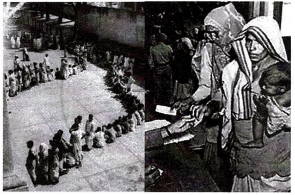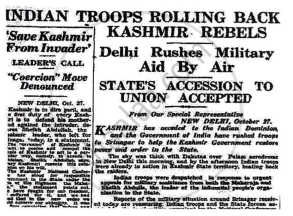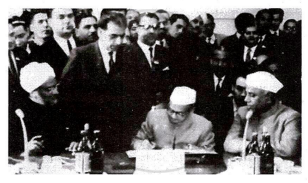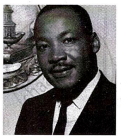ISC (Arts)
Academic Year: 2023-2024
Date & Time: 7th March 2024, 2:00 pm
Duration: 3h
Advertisements
- Candidates are allowed additional 15 minutes for only reading the paper.
- They must NOT start writing during this time.
- Answer all questions in Section A, Section B and Section C.
- The intended marks for questions or parts of questions are given in brackets [].
What was the most significant change made by the Mountbatten Plan in the Cabinet Mission Plan proposals?
Chapter: [0.015] Transfer of Power (1945-1947)
The Historic Eight Documents, authored by Charu Majumdar, served as the ideological foundation of the ______ Movement.
Chapter: [0.032] Naxal Movement
Name the leader of Mizoram Movement (1959 – 1986).
Chapter: [0.042] Return of Congress to Power (1979 – 1986).
Name any one organisation that pioneered the demonstrations against the evils of the dowry system in India.
Chapter: [0.06] Movements for Women’s Rights
Identify the Prime Minister of India who signed the Assam Accord (1985) with the leaders of the AASU and AAGSP.
Indira Gandhi
Morarji Desai
Rajiv Gandhi
Charan Singh
Chapter: [0.042] Return of Congress to Power (1979 – 1986).
Which one of the following was the primary reason for Italy's aggressive foreign policy that led to the outbreak of the Second World War?
Italy was not given the territories as promised to them by the Allies in a secret treaty signed in London.
Romania, Bulgaria and Yugoslavia asked Italy for military and financial help.
Italy decided to protect the sovereignty of Germany.
Italy aimed to counter the imperial policies of Britain and France in Asia.
Chapter: [0.013000000000000001] National Movement During the Second World War
A prominent political change took place on the midnight of 3rd October, 1990 in Europe, after the fall of Communism. Identify the political change being referred to above.
Lech Walesa became the leader of a free and united Poland.
The Commonwealth of Independent States (CIS) was created.
Alexander Dubeck was removed as the leader of Czechoslovakia.
Helmut Kohl became the first Chancellor of United Germany since the Second World War.
Chapter: [0.013000000000000001] National Movement During the Second World War
Assertion: Germany invaded Poland on 1st September, 1939.
Reason: Hitler had signed a Non-Aggression Pact with Russia in August 1939 and ensured Russian neutrality.
Both Assertion and Reason are true, and Reason is the correct explanation for Assertion.
Both Assertion and Reason are true, but Reason is not the correct explanation for Assertion.
Assertion is true and Reason is false.
Both Assertion and Reason are false.
Chapter: [0.07] World War II
The African leader imprisoned by the British government for twenty-seven years was ______.
Kwame Nkrumah
Jomo Kenyatta
Nelson Mandela
Chief Luthuli
Chapter: [0.015] Transfer of Power (1945-1947)
Name the original signatories of the Anti-Comintern Pact in 1936.
Chapter: [0.07] World War II
State any one difference between the freedom movement of Ghana and that of Kenya.
Chapter: [0.08] De-colonisation – in Asia (China) and Africa (Ghana and Keny
How did the Japanese attack on Pearl Harbour change the nature of the Second World War?
Chapter: [0.07] World War II
Mention any one challenge faced by Nkrumah after becoming the Prime Minister of Ghana.
Chapter: [0.08] De-colonisation – in Asia (China) and Africa (Ghana and Keny
Advertisements
State any one Act passed by the US Congress (1963 – 64) that sought to abolish gender discrimination in the US.
Chapter: [0.1] Protest Movements
What was the primary demand of the World Zionist Movement?
Chapter: [0.11] Middle East: Israeli-Palestine Conflict (1916- 1993).
In the context of the Middle East crisis, what is meant by the term Intifada?
Chapter: [0.11] Middle East: Israeli-Palestine Conflict (1916- 1993).
With reference to the image shown below, explain the results and the significance of the First General Elections in India in 1952.

Chapter: [0.02] Establishment and Development of Indian Democracy (1947 – 1966).
State any four developments during the J.P. Movement which led to the declaration of Emergency in June, 1975.
Chapter: [0.034] Emergency (1975-76)
Enumerate any four of the five principles that laid the foundation of the Non-Aligned Movement at the Banding Conference.
Chapter: [0.051] Non-aligned Movement (NAM)
One of the primary reasons for the outbreak of the Second World War was the policy of Appeasement followed by Britain and France.
Give any four reasons to explain why these two nations adopted the policy of Appeasement.
Chapter: [0.07] World War II
With reference to the World Economic Crisis (1929), give any four reasons to explain why Japan adopted an aggressive and militant foreign policy before the Second World War.
Chapter: [0.07] World War II
Which war is being referred to in the image of the news extract given below? Briefly explain any three causes of this war.

Chapter: [0.02] Establishment and Development of Indian Democracy (1947 – 1966).
The image given below shows the Prime Minister of India, Lal Bahadur Shastri and President of Pakistan, Ayub Khan attending a Conference in 1966.

- Where and after which war was this Conference held?
- State the two important outcomes of this Conference.
Chapter: [0.052000000000000005] Pakistan (1948-49, 1965, 1971)
President F. W. Klerk decided to end Apartheid and gradually move South Africa towards black majority rule. In this context discuss any four steps taken by Klerk to achieve his objectives peacefully.
Chapter: [0.1] Protest Movements
With reference to the Civil Rights Movement in the US, identify the activist leader shown below. Discuss any three contributions of this activist leader.

Chapter: [0.1] Protest Movements
Advertisements
Given below is a cartoon on the Marshall Plan. With reference to the cartoon, briefly discuss any four significant features of the Marshall Plan.

Chapter: [0.091] Origins of the Cold War
Name the Resolution that the All India Congress Committee passed on the 8th August, 1942. Why did Gandhi demand complete freedom immediately?
Chapter: [0.013000000000000001] National Movement During the Second World War
The popular upsurge in 1942 was crushed by the British Government, but the freedom struggle was carried on outside India by the Indian National Army. Discuss any four contributions of the Indian National Army with reference to the freedom struggle in India.
Chapter: [0.013999999999999999] Subhash Chandra Bose and the INA
Why did the Cripps Mission come to India? State any three proposals of the Cripps Mission.
Chapter: [0.013000000000000001] National Movement During the Second World War
Give any four reasons for the rejection of the Cripps Mission by the Congress and other political parties in India.
Chapter: [0.013000000000000001] National Movement During the Second World War
The Elections of 1977 brought a non - Congress government to power in India for the first time since Independence.
In the context of this statement, briefly discuss the following:
Any four policies of the new non-Congress government.
Chapter: [0.02] Establishment and Development of Indian Democracy (1947 – 1966).
The Elections of 1977 brought a non - Congress government to power in India for the first time since Independence.
In the context of this statement, briefly discuss the following:
Any four major drawbacks that led to the downfall of this government.
Chapter: [0.02] Establishment and Development of Indian Democracy (1947 – 1966).
Mao Zedong adopted a new economic policy to suit the special needs of the people of China. This policy was not based on the Russian model.
In this context, discuss any four features of the Great Leap Forward and its long term impact.
Chapter: [0.053] Sino-Indian War
Discuss any four causes of the Yom Kippur War (1973).
Chapter: [0.11] Middle East: Israeli-Palestine Conflict (1916- 1993).
Discuss any four consequences of the Yom Kippur War (1973).
Chapter: [0.11] Middle East: Israeli-Palestine Conflict (1916- 1993).
The Suez Crisis of 1956 was the result of the aggressive policies of all the nations involved in it. Discuss any four causes of this Crisis.
Chapter: [0.11] Middle East: Israeli-Palestine Conflict (1916- 1993).
The Suez Crisis of 1956 was the result of the aggressive policies of all the nations involved in it. Discuss any four consequences of this Crisis.
Chapter: [0.11] Middle East: Israeli-Palestine Conflict (1916- 1993).
Submit Question Paper
Help us maintain new question papers on Shaalaa.com, so we can continue to help studentsonly jpg, png and pdf files
CISCE previous year question papers Class 12 History with solutions 2023 - 2024
Previous year Question paper for CISCE Class 12 -2024 is solved by experts. Solved question papers gives you the chance to check yourself after your mock test.
By referring the question paper Solutions for History, you can scale your preparation level and work on your weak areas. It will also help the candidates in developing the time-management skills. Practice makes perfect, and there is no better way to practice than to attempt previous year question paper solutions of CISCE Class 12.
How CISCE Class 12 Question Paper solutions Help Students ?
• Question paper solutions for History will helps students to prepare for exam.
• Question paper with answer will boost students confidence in exam time and also give you an idea About the important questions and topics to be prepared for the board exam.
• For finding solution of question papers no need to refer so multiple sources like textbook or guides.
